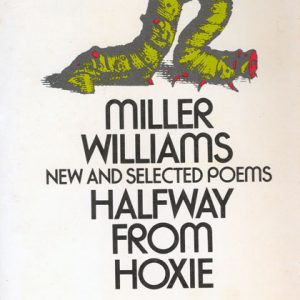calsfoundation@cals.org
Halfway from Hoxie
Published in 1973, Halfway from Hoxie: New and Selected Poems was Miller Williams’s fifth collection of poetry. This volume contains seventeen new poems and fifty-three poems from three of his earlier collections: A Circle of Stone (1964), So Long at the Fair (1968), and The Only World There Is (1971). Although Halfway from Hoxie presented a limited amount of new material, it fulfilled its stated purpose of providing “a tentative summary of [Williams’s] creative development during the past decade and a half.”
Halfway from Hoxie confirms Williams’s growing stature as a poet. By 1973, he had served as editor of the New Orleans Review and had received the Henry Bellamann Award (1957), the Breadloaf Writers Conference Fellowship (1961), and the New York Arts Fund Award (1970). In addition to his poetry collections, Williams had served as author, editor, or translator of nearly a dozen other books. He had also earned the respect and friendship of several major writers including Flannery O’Connor, John Ciardi, and Howard Nemerov.
Halfway from Hoxie takes stock of Williams’s body of poetry and demonstrates that he was quickly establishing himself as one of the foremost American poets of the late twentieth century. Williams’s status at the time of the publication of Halfway from Hoxie is also suggested by the critical reception of his earlier work. In the foreword to A Circle of Stone, Nemerov noted that Williams’s poems offer “terrible suggestions, older than meaning, [that] half-emerge from darkness,” and Williams’s work was widely and positively reviewed during the decade leading up to Halfway from Hoxie. In addition, most of the poems appearing in Halfway from Hoxie had originally appeared is such journals as the American Scholar, Chicago Review, Northwest Review, Southern Poetry Review, Prairie Schooner, and Southern Poetry Review.
Several of Williams’s trademark tendencies—his direct and accessible language, dramatic monologues and dialogues, depictions of everyday life, and sure craftsmanship—are on full display in this collection. Among the topics explored in the seventeen new poems are the actions of Judas, death of friends in childhood, pronouncements of love, the ennui of nursing homes, the space-time continuum, quirky neighbors, and the finality of death, all of which Williams approaches with honesty and directness as he probes the paradoxes, mysteries, and ecstasies of being human and mortal.
Stanley Miller Williams was born in Hoxie (Lawrence County) on April 8, 1930. Although he moved on to a long career of university teaching, founded literary journals, co-founded a university press, and published more than thirty books, he intentionally remained “halfway from Hoxie.” That is, he remained connected to places of his past and was fully attuned to realities of everyday life. Indeed, as he mentioned in numerous interviews, he was especially pleased when a critic referred to him as “the Hank Williams of American poetry,” which he interpreted to mean that his poetry could be read and understood by people of all social classes and backgrounds.
For additional information:
Burns, Michael, ed. Miller Williams and the Poetry of the Particular. Columbia: University of Missouri Press, 1991.
Pfefferle, W. T. Poets on Place: Tales and Interviews from the Road. Logan: Utah State University Press, 2005. Online at https://digitalcommons.usu.edu/usupress_pubs/87/ (accessed December 5, 2019).
Williams, Miller. A Circle of Stone. New York: E. P. Dutton Co. Inc., 1964.
———. Halfway to Hoxie. Baton Rouge: Louisiana State University Press, 1973.
———. Making a Poem: Some Thoughts about Poetry and the People Who Write It. Baton Rouge: Louisiana State University Press, 2006.
Phillip Howerton
Missouri State University
 Divergent Prosperity and the Arc of Reform, 1968–2022
Divergent Prosperity and the Arc of Reform, 1968–2022 Literature and Authors
Literature and Authors Halfway from Hoxie by Miller Williams
Halfway from Hoxie by Miller Williams 



Comments
No comments on this entry yet.